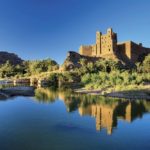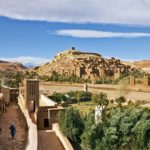Through this tour for National Geographic, César Barba takes us to the South of Morocco, over Marrakech and the Atlas Mountains, to the entrance of the Sahara Desert. (photos by National Geographic)
As a prelude to the fertile oasis splattered through the Sahara Desert, the city of Ouarzazate is an old caravan center, turned today into a strategic departure point for some of the best trips to the South of Morocco. It can be reached through a 3-hours journey from Marrakech, across the hillock of Tizi-n-Tichka (2,260 m). We find through this route one the region’s milestones, the Kasbah of Aït Benhaddou, declared World Heritage Site by UNESCO in 1987 and immortalized through films such as Lawrence of Arabia or Indiana Jones.
This adobe fortress presides over the Ounila Valley and it is one of the most ancient and magnificent ksour (fortified city) of Morocco. Close to Ouarzazate originates the long and fertile river Draa, that begins its journey by crossing the Atlas mountain range, making its way through deep gorges. When it reaches the city of Agdz (70 km from Ouarzazate), a tamer river gives birth to the Draa Valley, a real orchard that extends for 200 km, in contrast with the surrounding dry and reddish mountains.
The oasis on the Draa river
The road crosses the Draa Valley among its vegetable and fruit orchards and henna, as well as palm groves that produce the best dates of the country. Next to the river one can still see the dams, ditches and channels built by the primitive nomad tribes, that turned the valley into one the greenest spaces in the South of Morocco. In addition to this hydraulic techniques, the region is filled with kasbas and ksour, some of the strategically located for defensive purposes, and others hidden across the palm grove.
Right after passing Agdz, we find two of these important adobe monuments: the Aït Hamou Ou Said Kasbah, that rises proudly over the valley, with the river winding at its feet, and the ksar Tamnougalt, very well restored and surrounded by walls.
Road to the dessert
The trip continues towards the South, and reaches the city of Zagora, 90 km from Zagora. Zagora is today the base for the 4×4 cars leaving for the desert. It still keeps its famous poster announcing “Timbuktu, 52 days”, although it’s been a long time since the last camel caravan crossed the city on its way to the Niger River. At this point we begin to see the first Dunes in Tinfou, that announce the approach to the Great Sahara Desert.
The road ends in M’hamid, a small town located at the south end of the Draa Valley, at the gates of the Sahara Desert. From here leave the visits to the desert with one goal in mind: to reach the Erg Chigaga Dunes. The trips by 4×4 car or camel enter into this sea of sand and propose to spend the night in a khaima, under an impressive sky of stars. Led by the region’s guides, the visitor can discover the mysteries of the desert, and enjoy a majestic sunrise from the top of the dunes, enjoying a moment that will last forever in his mind.
Source: National Geographic Viajes
Translation: Alfonso Casani – FUNCI
This post is available in: English Español





